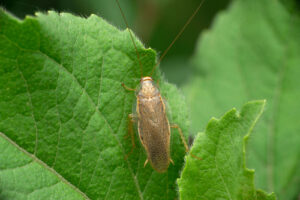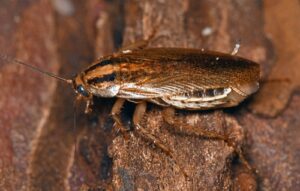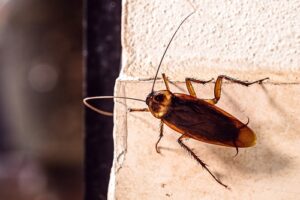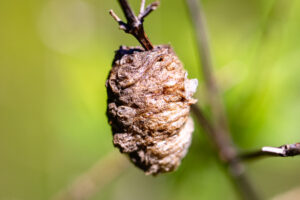Cockroaches – When to Take Action
By Zachary Ciras on May 19, 2025.
Understanding Common Cockroaches in New England
At Colonial Pest Control, we know that spotting a cockroach in your New England home can be unsettling. Not all roaches are the same, and understanding their differences can help you identify and address infestations effectively. In this blog, we’ll explore the key cockroach species found in New England—Pennsylvania wood roaches, German roaches, American roaches, Oriental roaches, and others—while shedding light on their entomological ties to termites and other relatives.
Pennsylvania Wood Roach
 The Pennsylvania wood roach (Parcoblatta pennsylvanica) is a native species thriving in New England’s forests, woodlands, and rural areas. Unlike the invasive roaches that plague homes, these roaches are outdoor dwellers, preferring to live under logs, in leaf litter, or beneath tree bark. Males, about an inch long and light brown, have fully developed wings and are capable of short flights, often drawn to porch lights or open windows at night, which can lead to accidental indoor sightings. Females, slightly smaller and wingless, are less mobile and rarely venture indoors. Their diet consists of decaying plant matter, fungi, and organic debris, making them ecologically beneficial as decomposers rather than household pests. Pennsylvania wood roaches are not adapted to indoor environments, lacking the ability to breed or survive long in homes, which distinguishes them from more problematic species.
The Pennsylvania wood roach (Parcoblatta pennsylvanica) is a native species thriving in New England’s forests, woodlands, and rural areas. Unlike the invasive roaches that plague homes, these roaches are outdoor dwellers, preferring to live under logs, in leaf litter, or beneath tree bark. Males, about an inch long and light brown, have fully developed wings and are capable of short flights, often drawn to porch lights or open windows at night, which can lead to accidental indoor sightings. Females, slightly smaller and wingless, are less mobile and rarely venture indoors. Their diet consists of decaying plant matter, fungi, and organic debris, making them ecologically beneficial as decomposers rather than household pests. Pennsylvania wood roaches are not adapted to indoor environments, lacking the ability to breed or survive long in homes, which distinguishes them from more problematic species.
Encounters with Pennsylvania wood roaches in New England homes are typically seasonal, peaking in late spring to early summer when males are most active. Their presence indoors often stems from structural vulnerabilities, such as unscreened windows or gaps around doors, especially in homes near wooded areas. Unlike German or American roaches, they don’t seek out human food sources or establish colonies indoors, so infestations are rare. However, their resemblance to other roaches can cause alarm. Homeowners can reduce sightings by sealing entry points, using screens, and minimizing outdoor lighting that attracts males. If you spot these roaches, there’s no need for panic—simple exclusion methods and a vigorous preventative maintenance program are usually enough, but Colonial Pest Control can assess your property to ensure long-term prevention.
German Roach
 The German roach (Blattella germanica) is the most common indoor pest roach in New England. Small, about half an inch long, they’re light brown with two dark stripes on their thorax. German roaches thrive in warm, humid areas like kitchens and bathrooms, feeding on crumbs, grease, and even soap. They reproduce rapidly—a single female can produce thousands of offspring in a year—making infestations tough to control without professional help. These roaches are notorious for spreading bacteria and triggering allergies.
The German roach (Blattella germanica) is the most common indoor pest roach in New England. Small, about half an inch long, they’re light brown with two dark stripes on their thorax. German roaches thrive in warm, humid areas like kitchens and bathrooms, feeding on crumbs, grease, and even soap. They reproduce rapidly—a single female can produce thousands of offspring in a year—making infestations tough to control without professional help. These roaches are notorious for spreading bacteria and triggering allergies.
American Roach
The American roach (Periplaneta americana) is one of the largest roaches, reaching up to two inches. Reddish-brown with a yellowish figure-eight pattern on their thorax, they’re often called “palmetto bugs.” In New England, they’re typically found in damp, dark areas like basements, sewers, or commercial buildings. While they can fly short distances, they prefer scurrying. American roaches are less common in homes but can enter through drains or gaps, feeding on decaying organic matter and starchy foods.

Oriental Roach
Oriental roaches (Blatta orientalis), or “water bugs,” are shiny black and about an inch long. They prefer cool, damp environments like basements, crawl spaces, or under sinks. In New England, they’re often found near drains or leaky pipes. Males have short wings, while females are wingless, and neither can fly. Oriental roaches are slower than other species and feed on decaying matter, making them less likely to invade pantries. However, their presence can indicate moisture issues in your home.
Other Roaches in New England
Less common species include the brown-banded roach (Supella longipalpa), which is smaller and prefers warmer, drier areas like bedrooms or furniture. Smokybrown roaches (Periplaneta fuliginosa) are rare in New England but may appear in warmer coastal areas. Both are less prevalent than German or American roaches but can still cause problems if introduced through travel or shipments.
Entomological Connections
Cockroaches, termites, and other insects like mantids and stick insects belong to the superorder Dictyoptera. Entomologists classify cockroaches and termites in the order Blattodea, reflecting their close evolutionary ties. Termites, once considered a separate order (Isoptera), are now recognized as a type of social cockroach due to genetic and behavioral similarities. Both share winged and wingless forms, produce oothecae (egg cases), and exhibit complex social behaviors in some species. For example, wood-eating cockroaches like the Cryptocercus genus share gut microbes with termites, aiding cellulose digestion—a trait linking their diets and habitats.

Mantis Ootheca in a Hanson, MA garden
Mantids, classified in the order Mantodea, are more distant Dictyopteran relatives but share key traits with cockroaches and termites. Known as praying mantises, these predatory insects are common in New England gardens, with species like the European mantis (Mantis religiosa) thriving in temperate climates. Their triangular heads, raptorial forelegs, and oothecae resemble those of roaches, reflecting a common ancestry. Unlike the scavenging or social behaviors of roaches and termites, mantids are solitary hunters, feeding on other insects, which makes them beneficial for natural pest control. This diversity within Dictyoptera underscores the adaptability of these insects across ecological niches.
Unlike termites, which form highly organized colonies, most cockroaches are solitary or loosely social. Their shared ancestry is evident in physical traits like flattened bodies and long antennae, adapted for navigating tight spaces. Mantids, while more distantly related, share Dictyopteran traits like egg-laying structures, highlighting the group’s diversity.
Why It Matters
Identifying the roach species in your home is crucial for effective pest control. German roaches require aggressive indoor treatments, while wood roaches may only need exclusion methods, landscaping to reduce harborage opportunities, and a preventative maintenance barrier treatment. At Colonial Pest Control, our experts tailor solutions to your specific infestation, addressing moisture, entry points, and sanitation. If you spot roaches, don’t wait—contact us for a thorough inspection and customized plan to keep your New England home pest-free.